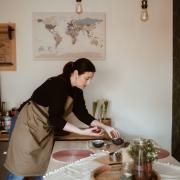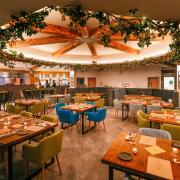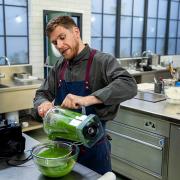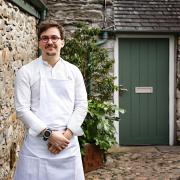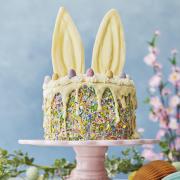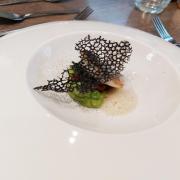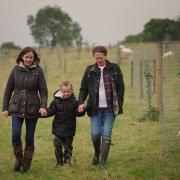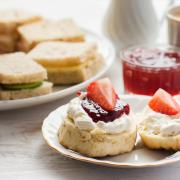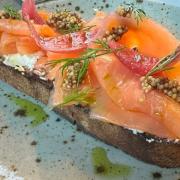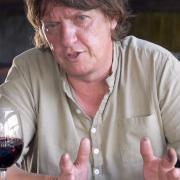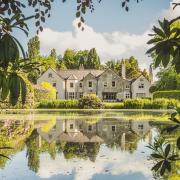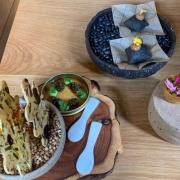A new book by Emma Kay doesn’t just celebrate any old food, it celebrates old Lancashire food - and reveals that some of our traditional dishes aren’t Lancastrian after all
‘When I was young I loved eating at friends’ houses because it was a chance to have chips and beans – things we never had at home.’
Home-cooked meals in Emma Kay’s childhood tended to be experimental Middle Eastern inspired dishes concocted by her mum, or traditional working class fare cooked up her grandmother.
Now though, Emma is equally at home with a wet nelly, pea whack or lonk.
After a career which took her to senior management posts at some major museums, Emma has carved out a new life as a food historian, author and collector of kitchenalia.
Her latest book is a celebration of Lancashire’s food heritage, inspired in part by recipes learned from her Freckleton-born husband’s family.
The book, Foots, Lonks and Wet Nellies: Lancashire's Food and Drink, which comes out this month traces the history of some largely-forgotten dishes and others that have endured rather better.

Emma grew up in Worcester in the 70s and 80s and said: ‘I had a quite privileged upbringing – my parents had houses in Devon and Cyprus. I was the youngest and I got a lot of attention and saw quite a bit of the world. I was extraordinarily lucky, to be honest.
‘My mum was an amazing cook. She loved Middle Eastern style food and was always experimenting so we always had incredible meals at home. We travelled a lot with my dad’s work in metal manufacturing and they would bring back all kinds of recipes and ideas for meals. We had a lot of Cypriot and Greek food and we ate out an awful lot as well.
‘My grandmother lived with us all my childhood and she was a very different kind of cook – she would use very traditional ingredients such a brains, tongue and we had a lot of kidneys on toast. I learned a lot about food from her.
‘I guess I had a very mixed kind of introduction to food – I did long for fish fingers sometimes.’
When she left a management role at the British Museum, Emma took a job at Bath University and moved to a house in the Cotswolds.
‘For no reason I know I started collecting kitchenalia,’ she added. ‘Someone gave me a gift of some 1930s Denbyware and from then on I kept buying little bits of vintage and antique kitchenware. I kept adding to my collection – I can hardly get into the garage now, there’s about 400 objects.
‘About a decade ago I started a website about the objects and writing a blog about them and out of the blue I was sent an email from a publisher asking if I wanted to do a book on the history of food. There weren’t many food historians at that time and I had a slightly new angle on it all.
‘Since that first book, things have exploded - I've done a lot of television and radio and podcasts and all kinds of things. I’ve done nine books so far and I have another two or three coming out this year and two more next year.’
And while her books and media work have taken her far and wide, her latest book is liberally seasoned with an obvious affection for Lancashire.
‘I love it in Lancashire, it’s all so beautiful. I love the people and I really wanted to celebrate the food. I particularly love the coastline from Morecambe down to Fleetwood and Blackpool. I love the fact that you can be by the dramatic coast and then just a few minutes later you can be in the wonderful hills.
‘It puzzles me that more people don’t go there – people are so obsessed with Devon and Cornwall and they just don’t seem to consider Lancashire and yet it’s all so beautiful. It does get cold, though.’
And while the book does celebrate our regional dishes and rejoices in some of our culinary gifts to the world - ‘Jelly babies, Fisherman’s Friend, suet and all kinds of other things (although Atora suet was invented by a Frenchman while he was in Lancashire)’ - it also claims some dishes we thought were ours, might not be.
‘The book de-bunks some of the myths about Lancashire food, so there are some things in there that Lancastrians may not be happy about: hot pot is not a Lancashire dish, and nor is black pudding,’ Emma said.
‘There was a version of hot pot first mentioned in London and black pudding came with the Romans. I do celebrate the foods that are from Lancashire, though, and I hope people will forgive me for saying what isn’t from Lancashire.’

Five to try at home
Author Emma Kay's selection of traditional Lancashire recipes from her book Foots, Lonks and Wet Nellies: Lancashire's Food and Drink,.
Hindle wakes

Attracted by the area’s textile industry, Flemish weavers settled in Bolton-le-Moors in the medieval period. They allegedly brought with them a recipe for Hindle Wakes (Hen De La Wake or Hen of the Wake).
There could be two reasons for this name; Medieval Wake Nights were nights when the corpse of the dead was kept in the house and lights, prayers and hymns were chanted to prevent Satan from stealing the body, while Wakes were also known locally as annual holiday weeks. Hindle may refer to Hindley, near Wigan.
No one quite knows the origin of Hindle Wakes, but I would like to think of it as an ancient dish introduced by early Dutch-Belgian migrants. In 1910 a play of the same name, tackling class divisions, about a mill girl and a mill owner’s son having an affair was published by Stanley Houghton. This was later adapted for the screen and Hindle Wakes the movie was released in 1952.
Dorothy Hartley reproduced a recipe in her 1954 book, Food in England, claiming it to have been sourced from a family living near Wigan in 1900. Hartley did not provide references, so authentication remains a mystery.
The process of making Hindle Wakes involved preparing an old fowl which had been hanging for some time to mature. The stuffing was made using half a loaf of dry bread mixed with twice the number of prunes. This was seasoned with salt, pepper, and herbs, before adding a cupful of vinegar.
Next a handful of suet was stirred into the mix and the fowl stuffed, trussed, and boiled overnight in water, vinegar, and brown sugar. The hen was then left to go completely cold before being coated with a lemon sauce and served as the main dish during the start of the wake holiday.
Eccles cakes
While Chorley cakes are made using unsweetened shortcrust pastry, Eccles cakes, from Manchester were traditionally formed from flaky pastry with a sugar topping and sometimes served with cheese. Both of these cakes are related to early ‘fairings’ which were small spiced or highly flavoured cakes, sold at fairs and festivals to take home as gifts.
Chorley and Eccles cakes are also often historically linked to Banbury cakes. Some recipes for Eccles cakes, like the one published in The Complete Practical Pastry Cook , (1889) suggest using the ‘Banbury meat’ as the basis for making the cake. James Birch is the baker typically credited with creating the Eccles variety we are familiar with today, sometime towards the end of the 1700s. The recipe I have included here is from The Pastrycook and Confectioner’s Guide, 1889, to demonstrate the once broad variety of Eccles Cake recipes. This same book includes a recipe for ‘Eccles or Nelson Cake’, using the traditional method of puff pastry circles filled with currants.
Mix a small quantity of cream of tartar and soda in 2lbs of flour, rub in the flour 1lb lard, then add 12ozs of currants; work with a little water into a nice stiff dough, pin out, cut with a fluted cutter, egg the top, dust with castor sugar, and bake on sheet tins in a sharp oven. This quantity will make 40 cakes, and they will be found good for coffee-house use, say at a halfpenny each.
Pea wack

Peas were very important to Lancashire and you can read all about why in the book. Pea Whack/Wack is a Liverpudlian term, for pea and ham soup, whack, meaning a portion or share of. The recipe I have included here is from Elizabeth Raffald.
Although born in Doncaster, she moved to Manchester where, over the next 18 years she reportedly ran two pubs, two coffee shops, an indoor and outdoor catering business, delivered cookery lessons and opened Manchester’s first registry office – an employment agency for servants. She also embarked on other great pioneering local enterprises and wrote one of the most successful titles of her time in terms of sales. The following recipe is taken from this book The Experienced English Housekeeper, 1771.
To make green pea soup
Shell a peck of peas and boil them in spring water till they are soft; then work them through a hair sieve; take the water that your peas were boiled in, and put in a knuckle of veal three slices of ham, and cut two carrots, a turnip, and a few beet leaves shred small; add a little more water to the meat; set it over the fire, and let it boil one hour and a half; then strain the gravy into a bowl, and mix it with the pulp ,and put in a little juice of spinage, which must be beat and squeezed through a cloth; put in as much as will make it look a pretty colour; then give it a gentle boil, which will take off the taste of the spinage; slice in the whitest part of a head of celery; put in a lump of sugar the size of a walnut; take a slice of bread, and cut it in little square pieces; cut a little bacon in the same way; fry them a light brown in fresh butter; cut a large cabbage lettuce in slices; fry it after the other; put it in the tureen with the fried bread and bacon; have ready boiled as for eating, a pint of young peas and put them in the soup, with a little chopped mint if you like it, and pour it into your tureen.
Tharf cake

Tharff, or Tharf/Thor/Thar cake was a coarse oatmeal and treacle cake, which was often attributed to Derbyshire and Yorkshire, but in older works it is nearly always connected to Lancashire. It derives from the old English term, tharf, meaning need or necessity.
It was a lot like a flat Parkin, also eaten around November 5, a date that coincides with an ancient feast in honour of Thor. In John Trotter Brockett’s A Glossary of Northern Country Words, he explains that Tharf cakes were rolled out very thinly and might also consist of rye and barley. They were often hung up in large quantities, with a pole that ran through the centre for storage. Thar-Cake Monday, was also the first Monday following Halloween. A quote taken from History of the Borough of Bury and Neighbourhood: In the County of Lancashire, 1874, notes: ‘There was a kind of cake made in Bury and its neighbourhood during the first five days of November each year – and at no other time…This bread was designated ‘Thar-Cake’…’Thor Cake’. ‘
Some recipes contained ginger, but this version of mine is more basic and cooked on a traditional griddle.
200g plain flour
100g oatmeal
150g butter
100g black treacle
Add the butter to the flour and oatmeal. Mix until smooth. Lightly warm the treacle, add to the other ingredients, and bring the mixture together. Knead gently, roll out and shape into rounds. Cook on a hot griddle or for about 10 minutes in the oven at around 160°c.
Gingerbread

Gingerbread recipes vary hugely across Lancashire. You can find a genuine original recipe for the county’s most famous Ormskirk gingerbread in the book. Here is one for ‘Black Gingerbread’ published in the Liverpool Echo, 1929.
To 1lb of black treacle take 1lb flour, ½ lb margarine, 6oz sugar, 3 eggs, 2 teaspoonfuls ground ginger, 2 teaspoonfuls mixed spice, ½ tsp bicarbonate of soda, ½ pint milk, ½ ounce chopped almonds or other nuts.
Line a deep baking tin with greased paper. Melt the margarine first in a saucepan, then add the treacle, sugar and milk, and beat all these slowly until the sugar is dissolved.
Well mix the flour and spices in a basin with the nuts. Pour and mix in the treacle etc and the well-beaten eggs. Mix the soda with a little milk, add and stir it most thoroughly. Pour the mixture into a prepared tin and bake the cake carefully in a moderately hot oven for one and a half to two hours and cool in the tin before cutting.



